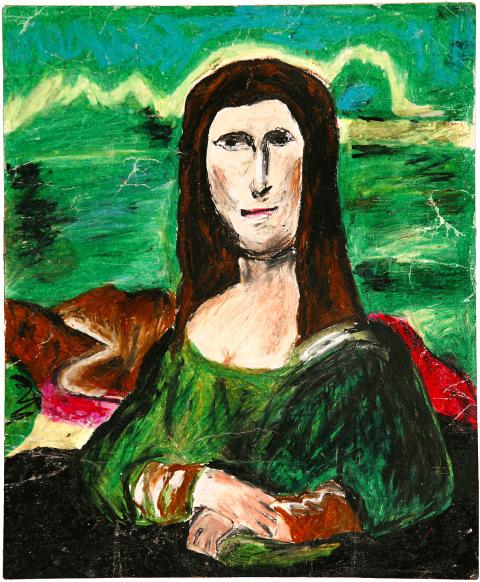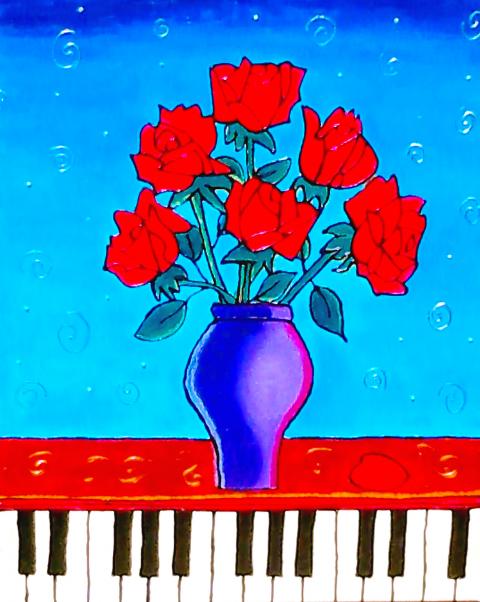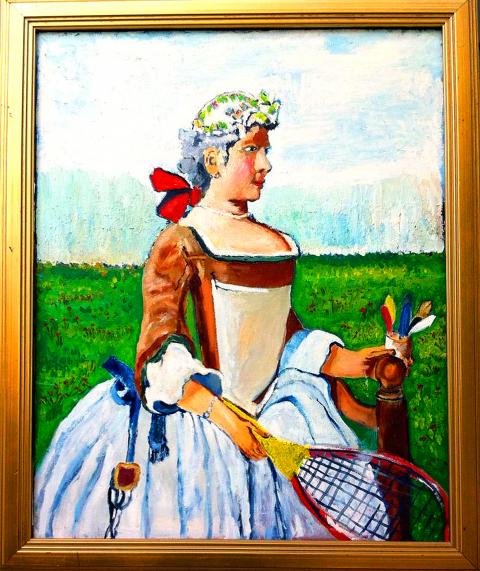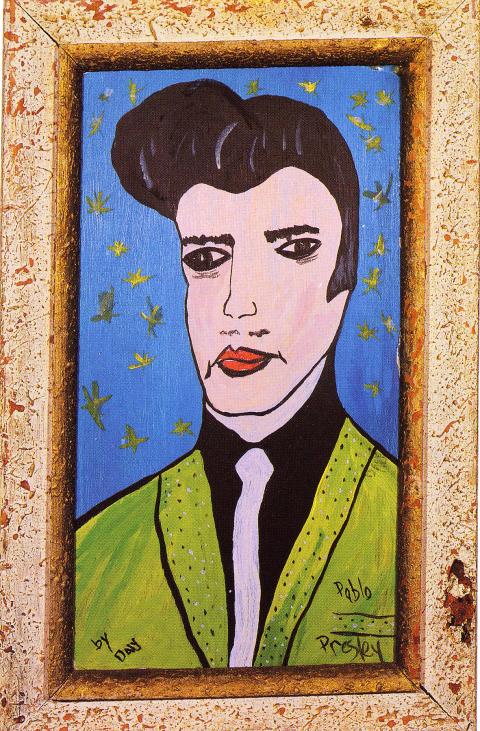Sixty paintings from the Boston-based Museum of Bad Art (MOBA) are currently on display at the Huashan 1914 Creative Park. Created not by acclaimed artists but ordinary people, these works boast oddities, absurdities or simply ugliness — qualities that are equally as eye-catching as exquisite fine art.
The museum numbers more than 600 pieces in its permanent collection, many of them purchased from thrift shops, yard sales and secondhand stores. Part of the collection was donated by its creators, while some were retrieved from rubbish bins.
To be accepted by MOBA, the work must be original, have had no prior appearance in a museum or gallery, and possess a certain attention-grabbing quality.

Photos Courtesy of Kuan Hung Arts
For example, Mama and Babe — a half-length portrait of two females with rigid facial contours — screams contrasting colors of red and green. Its title suggests that the figures are mother and daughter, and the explanatory panel indicates that the mother is a parody of a former US first lady.
Poor execution of artistic expression doesn’t guarantee a ticket to MOBA’s collection. Pablo Presley was selected for showcasing a version of Elvis Presley that’s different from the typical Elvis-in-black-velvet portraits found in many souvenir shops, says the exhibition catalog. The creator of this painting, Bonnie Daly, had taken another approach, interpreting the King of Rock ‘n’ Roll in the style of Pablo Picasso.
Some paintings look like nothing special until closer examination. Red Rose Serenade features a piano keyboard with incorrectly arranged keys — an oddity that begs an observant eye to detect it.

Photos Courtesy of Kuan Hung Arts
The exhibition includes several imitations of masterpieces. Badminton Anyone? vaguely resembles 18th-century French painter Jean-Baptiste-Simeon Chardin’s Girl with Shuttlecock in terms of composition. But Badminton Anyone? features a boyish-looking woman and a modern-day racquet that stray from the original big-time, and its far-from-competent technique evokes a smile.
Even though MOBA seems to imply there’s a such thing as “bad art,” its underlying message calls for an open-minded spirit in art appreciation. By showing ordinary paintings that were never meant to enter fine art museums or to be displayed in public, MOBA questions what qualifies as art. Amateur artists may lack the sophisticated drawing skill of professionals, but the value of their works isn’t necessarily lesser.
That being said, many of the explanatory panels in this exhibition illuminate not only how MOBA acquired the work but also provide art commentary, which either leads or limits the viewer’s mind. Instead of including commentary on the panels, curators should have set up a separate section for such information to avoid explaining too much on the spot.

Photos Courtesy of Kuan Hung Arts
Another problem is that the 60 paintings are categorized into 11 sections based on confusing, often capricious criteria. For instance, paintings in the Poker Area don’t really have anything to do with the card game, but are simply presented on large poker cards. Other sections such as the Furnace Area, Bed Area and Spider Net Area are home to paintings that would otherwise have been burnt, hidden under the bed or covered by a spider net, but the value of grouping paintings in this way was lost for this reviewer. Without this extra layer of meaning imposed on the paintings, MOBA’s message might have been more accessible.

Photos Courtesy of Kuan Hung Arts

Photos Courtesy of Kuan Hung Arts

Photos Courtesy of Kuan Hung Arts

In the March 9 edition of the Taipei Times a piece by Ninon Godefroy ran with the headine “The quiet, gentle rhythm of Taiwan.” It started with the line “Taiwan is a small, humble place. There is no Eiffel Tower, no pyramids — no singular attraction that draws the world’s attention.” I laughed out loud at that. This was out of no disrespect for the author or the piece, which made some interesting analogies and good points about how both Din Tai Fung’s and Taiwan Semiconductor Manufacturing Co’s (TSMC, 台積電) meticulous attention to detail and quality are not quite up to

It is one of the more remarkable facts of Taiwan history that it was never occupied or claimed by any of the numerous kingdoms of southern China — Han or otherwise — that lay just across the water from it. None of their brilliant ministers ever discovered that Taiwan was a “core interest” of the state whose annexation was “inevitable.” As Paul Kua notes in an excellent monograph laying out how the Portuguese gave Taiwan the name “Formosa,” the first Europeans to express an interest in occupying Taiwan were the Spanish. Tonio Andrade in his seminal work, How Taiwan Became Chinese,

Mongolian influencer Anudari Daarya looks effortlessly glamorous and carefree in her social media posts — but the classically trained pianist’s road to acceptance as a transgender artist has been anything but easy. She is one of a growing number of Mongolian LGBTQ youth challenging stereotypes and fighting for acceptance through media representation in the socially conservative country. LGBTQ Mongolians often hide their identities from their employers and colleagues for fear of discrimination, with a survey by the non-profit LGBT Centre Mongolia showing that only 20 percent of people felt comfortable coming out at work. Daarya, 25, said she has faced discrimination since she

April 21 to April 27 Hsieh Er’s (謝娥) political fortunes were rising fast after she got out of jail and joined the Chinese Nationalist Party (KMT) in December 1945. Not only did she hold key positions in various committees, she was elected the only woman on the Taipei City Council and headed to Nanjing in 1946 as the sole Taiwanese female representative to the National Constituent Assembly. With the support of first lady Soong May-ling (宋美齡), she started the Taipei Women’s Association and Taiwan Provincial Women’s Association, where she